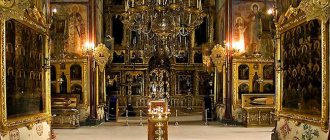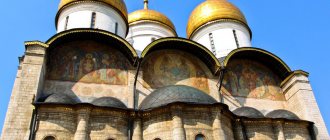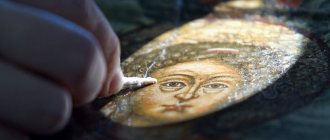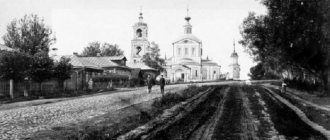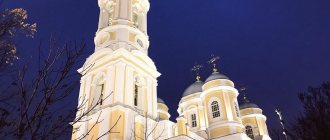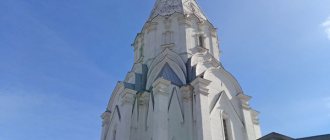| Moscow Church of the Twelve Apostles in the Patriarchal House in the Kremlin |
Moscow Church in the name of the Twelve Apostles in the Patriarchal House in the Kremlin with the chapel of the Apostle Philip
of the Moscow Diocese
- Sees: Cathedral of the Twelve Apostles (main); ap. Philippa (altar)
- Address: Russia, 101000, Moscow, Kremlin, Cathedral Square
- Tel.
- Website in the Network of Orthodox Websites - Prihod.ru
: - On the map: Yandex.Map, Google map
The temple is located on the Kremlin's Cathedral Square, north of the Assumption Cathedral.
On its eastern side, the temple is connected by a gallery to the Patriarchal Chambers in the Patriarchal Courtyard. Directions - to the metro station "Alexandrovsky Sad", "Borovitskaya". In 1566-1568, the Church of the Solovetsky Wonderworkers Zosima and Savvaty was built at the metropolitan courtyard on this site. It also had a chapel of the Apostle Philip and is believed to have been built by Metropolitan Philip, former abbot of Solovetsky.
In the middle of the 17th century, Tsar Alexei Mikhailovich gave Patriarch Nikon the empty Tsar Borisov courtyard, adjacent to the Patriarchal courtyard. The territory of the Patriarchal Court thus increased, and in place of the temple of the Solovetsky Wonderworkers, the current impressive temple was built between 1652 and 1656, originally consecrated in the name of the Apostle Philip. Construction work was carried out by Russian masters Antip Konstantinov and Bazhen Ogurtsov. The place of the dismantled church was taken by the porch of the new temple and the newly formed vestibule leading to Nikon's stone cells, built on the north. The passage to the Patriarch's Front Yard was arranged in the basement of the Philippovskaya Church.
In 1681, the temple was re-dedicated in the name of the Twelve Apostles, and on the third floor of the patriarchal house at the patriarch’s cells a house church was built in the name of the Apostle Philip.
Since 1721, the temple was under the jurisdiction of the Synodal Office and was rebuilt many times. In 1722, the architect I.P. Zarudny, under the heads of the cathedral, built a sacristy and installed a new iconostasis. From the second half of the 18th century, there was an apocalypse in the Cross Chamber of the Patriarchal Court, and the ointment itself was kept in the altar of the Church of the Twelve Apostles.
In 1917, the Cathedral of the Twelve Apostles and the Church of the Apostle Philip were severely damaged during the artillery shelling of the Kremlin by Bolshevik supporters - a large Holy Crucifix was broken, the patriarchal sacristy was turned into a pile of rubbish, and the Gospel of 1115 was damaged. In 1918, the churches were closed and included in the Moscow Kremlin Museums. The second floor of the Patriarchal House, including the cathedral, the Refectory, the Cross and other chambers, was occupied by the exhibition of the Kremlin Museum of Applied Arts and Life of Russia of the 17th century. Since the 1920s, restoration has been carried out.
From the large complex of the Patriarchal Court, the Church of the Twelve Apostles, the building of residential chambers with the Church of the Apostle Philip and the Chrism Chamber have survived to this day. The dining room adjacent to it has been extensively rebuilt. The Patriarchal sacristy was partially destroyed and scattered among other museums. The carved wooden iconostasis of the late 17th century located in the church was moved in 1929 from the destroyed cathedral of the Ascension Monastery. Nowadays, the entire second floor of the Patriarchal House, including the temple, refectory, Cross and other chambers, is occupied by the exhibition of the Museum of Applied Arts and Life of Russia in the 17th century. The Temple of the Apostle Philip was destroyed: only the altar remained, located on the south side of the chambers.
In the early 1990s, the Church of the Twelve Apostles was transferred to the Russian Orthodox Church, after which once a year, on the patronal feast day, the Divine Liturgy began to be celebrated there. Access to the temple is now by invitation. The rest of the time the church acts as a museum. The Church of the Apostle Philip is now listed as its chapel.
Architecture
The temple is a four-pillar cross-domed building on a high basement, cut through by two arcades for passage from the Cathedral Square to the inner Patriarchal Courtyard. Built according to the models of Vladimir-Suzdal churches. Columnar arcature was introduced into the design of the drums of the slender five-domed structure. The same motif is present on the facades, where two tiers of arcature-columnar belts serve as frames for window openings and unite the temple building with the adjacent chambers, as well as with the Assumption Cathedral. On the northern facade there is a high two-tier porch, common to the church and chambers, in the decoration of which tiles are used. Fragments of wall paintings from the late 17th century have been preserved.
The hall of the Cross (Mirbrew) Chamber (14 x 20 m) of the Patriarchal Court is covered with a single vault without intermediate supports, which was an outstanding technical innovation for its time.
Cathedral of the Twelve Apostles in the Kremlin
Photo from the book by N.A. Naydenova
The only church in Moscow consecrated in the name of this holiday is located in the Kremlin: through its beautiful arches we usually pass to Cathedral Square, with which it forms a single ideological and architectural ensemble along with the three main Kremlin cathedrals - the Assumption, Archangel and Annunciation. However, unlike its great neighbors, the Church of the Twelve Apostles is the most recent of them. It was built in the middle of the 17th century by order of Patriarch Nikon along with the magnificent Patriarchal Chambers and since then has become the patriarchal church of the house. With this majestic ensemble, Patriarch Nikon asserted his priority in the political dispute with the tsar about the advantages of spiritual power over secular power.
The Feast of the 12 Apostles appeared in the 4th century AD, when in the Church, along with the veneration of each apostle, a general honoring of all the apostles of Christ was established on different days of the year. And the date of this holiday was chosen the next day after the celebration of the memory of the supreme apostles Peter and Paul. Already Emperor Constantine the Great built a temple in the name of the Holy Twelve Apostles in the Byzantine capital of Constantinople.
Russian church hierarchs previously had their own home church in the Kremlin. It was the small Church of the Deposition of the Robe near the Assumption Cathedral, built in 1451 by Saint Jonah, Metropolitan of Moscow, in his courtyard in gratitude for the miraculous salvation of the capital from the raid of the Horde prince Mazovsha: July 2 (15), on the feast of the Deposition of the Robe of the Mother of God in Blachernae, his the army appeared near Moscow, and on the same day suddenly turned back without a fight, which is why this raid was popularly called the “quick Tatar”. The current building of this first house church was built in 1484–1486. the same Pskov masters Krivtsov and Myshkin who built the Annunciation Cathedral - after they suffered a terrible failure with the construction of the Assumption Cathedral, which collapsed to the ground.
After the establishment of the patriarchate in Rus', the Church of the Deposition of the Robe became the first Kremlin house church of the Russian patriarchs - until the time of Patriarch Nikon. Nikon planned to build a new Patriarchal house, majestic and ceremonial, no worse than the royal Terem Palace ,
with its own house church. The site for construction was determined on the Kremlin territory of the Patriarchal Court, which was given for the Russian metropolitan by the Grand Duke Ivan Kalita himself, when St. Peter moved his see from Vladimir to Moscow, making it the ecclesiastical capital of the Russian state. And in 1450, the first stone chambers of the metropolitan court appeared here.
However, the Cathedral of the 12 Apostles did not appear in the Kremlin immediately. Also St. Philip, Metropolitan of Moscow, built a church here in the name of the holy Solovetsky wonderworkers Zosima and Savvaty with a chapel in the name of his heavenly patron, St. Apostle Philip. It is likely that it was also a home metropolitan church together with the official Robe. When Nikon achieved enormous power, he attributed his success, as the historian Ivan Zabelin believed, to the favor and heavenly help of his predecessor, St. Metropolitan Philip, and ordered the construction of a new stone church in the name of St. on the site of the Solovetsky Cathedral. Apostle Philip, consecrated by the name of the Moscow saint. Part of the former courtyard of Boris Godunov was also allocated for extensive construction.
In September 1652, two months after the “repentant” meeting of the honorable relics of St. Philip at the Krestovskaya Gate, the construction of the Kremlin Cathedral began, and at the end of February 1656, Patriarch Nikon was already serving the Liturgy in the new church. The powerful, five-headed, handsome giant with crosses covered with gilded copper became a classic example of Nikon’s church architecture. After Nikon banned Russian hipped-roof architecture in temple construction in 1648 and ordered the construction of “Byzantine” cross-domed five-domed churches everywhere, he himself followed his decree, building his own house church in the Kremlin in this style. The solemn grand building of the patriarchal house church symbolized the power and greatness of Patriarch Nikon. Here, it was emphasized that only monastic clergy served, while in other Kremlin cathedrals, including the Tsar’s Annunciation, there were white clergy. And the old Church of the Deposition of the Robe, after the construction of a new house patriarchal church at the chambers, became a palace church and was connected by stairs to the royal towers.
The entire ensemble of the Patriarchal Court with the cathedral took twenty years to build - from 1636 to 1656, and was erected by Russian masters Antip Konstantinov and Bazhen Ogurtsov, and the luxurious building of the Patriarchal House with the famous Chamber of the Cross was built by the architect Davyd Okhlebin. And already in 1655, Patriarch Nikon met Tsar Alexei Mikhailovich, who returned with victory from Vilna, in his new Kremlin possessions. Here he solemnly received the sovereign and blessed him. From then on, until Peter’s reforms, kings came to the Patriarchal Court on their name day with a festive cake and received blessings and congratulations from the Primate in the Cross Chamber.
Here, in the Chamber of the Cross, its creator, Patriarch Nikon, himself appeared before the court of the Ecumenical Patriarchs. And since the time of Empress Catherine II, a World Warehouse was established in it, where St. Myrrh for all of Russia was brewed during Holy Week and kept in the Patriarchal Sacristy. At the chambers there was also the largest priceless Patriarchal (Synodal) library in Russia with rarities.
And only in 1680–1681, many years after the fall of Patriarch Nikon, the Kremlin Cathedral in the name of the Apostle Philip was reconsecrated in the name of the Twelve Apostles by personal order of Patriarch Joachim, and in the name of St. Apostle Philip built a small church on the top, third floor of the Patriarchal Chambers, which became the new home church of the Russian Patriarch.
Sometimes pre-revolutionary historians even attributed the appearance of the Church of the Twelve Apostles to the late reign of Peter I. Allegedly, in 1723, after the abolition of the patriarchate and the creation of the Holy Synod, the tsar ordered the construction of a church above the cells of the “Synodal House” (which was located in the former Moscow chambers of the patriarch). the name of the Twelve Apostles with the upper chapel of St. Apostle Philip. They also believed that the temple built under Nikon - the future Twelve Apostles - was not first consecrated in the name of St. Apostle Philip, and in the name of the three Moscow saints - Peter, Alexei and Jonah with the chapel of the newly glorified Metropolitan Philip, in order to emphasize the historical continuity of Patriarch Nikon. Modern historians generally do not support either of these versions.
The Kremlin Church of the Twelve Apostles had its own shrines and relics, one of which was the ancient Byzantine double-leaf image of the Holy Apostles Peter and Paul, presented to Peter I by Pope Clement. And on the outer wall of the temple above the former patriarchal gate was the Image of the Savior Not Made by Hands. Once, during construction work, part of the wall collapsed, and these bricks fell to the ground, but miraculously the Face of the Savior was preserved on them, and He could be seen at the beginning of the twentieth century.
The temple suffered terribly during the November battles of 1917, coming under artillery fire. Shells pierced its walls and destroyed the interior, which was later restored with great difficulty by museum workers. A new iconostasis to replace the destroyed one was moved from the cathedral of the Kremlin Ascension Monastery, which was blown up by order of the new residents of the Moscow Kremlin.
And already in 1922, the ancient gallery connecting the temple with the living quarters of the patriarch was restored, and the ancient chambers themselves were opened. Later, the floor of the cathedral was again covered with glazed tiles. Currently, the temple houses a museum exhibition. From the upper temple of the Apostle Philip, only the altar remains, and there is now no access to it.
Clergy
Abbots
- Sschmch. Leonid Chichagov (1893 - 1896)
- Mikhei (Alekseev) (December 4, 1896 - December 1897)
- Feodosius (Almazov) (1903 - 1905)
- Boris (Shipulin) (1905 - 1906)
- Sschmch. Dimitry (Dobroserdov) (1908 - 1914)
Priests
- Arseny (mentioned 1914) Hierarch.
- Barsanuphius (mentioned 1914) Hierom.
- Savva (mentioned 1914) Hierom.
Deacons
- Evstratiy (mentioned 1914) hierod.
- Anthony (mentioned 1914) hierod.
Power struggle
The “Worship of the Cross” icon is a unique illustration of the struggle for supremacy in the Russian state, which has played out since 1658 between the ruler and the patriarch.
Nikon made his way to the heights of church power in such a short time that this success decisively turned his head, and first in a private setting, and then in his sermons, he began to proclaim that “the priesthood is above the kingdom,” practically encroaching on the absolute power of the Russian monarch.
The result of this was a gap between the tsar and the patriarch, the “war of letters” that lasted for several years, the deposition of Nikon at a church council in 1666, his exile and premature death.
"Worship of the Cross." 17th century icon
The “Adoration of the Cross” icon was painted after the fact and indicates what the patriarch’s place should be in the state hierarchy: below the king and on his knees before him.
Returning to the vestibule, you can go to the patriarch’s working rooms. Nothing has survived from the original furnishings of this part of the Patriarchal Palace. However, you can get some idea of how, from the middle of the 17th century, Western household items gradually began to penetrate into the life of wealthy Muscovites.
The Patriarchal Chambers were built in the 17th century by Russian architects
By order of Patriarch Nikon, the Church of the 12 Apostles and the Patriarchal Chambers were built
The Temple of the 12 Apostles and the Patriarchal Chambers were built by Russian architects Antip Konstantinov and Bazhen Ogurtsov in 1653 - 1656 by order of Patriarch Nikon. The patriarch at that time competed with the king, trying to establish patriarchal power above the royal one.
It was for this purpose that, instead of the old Patriarchal residence, he ordered the construction of a new one, on the site of part of Boris Godunov’s courtyard and the old house church. Near his Residence, Nikon ordered the construction of a five-domed Cathedral of the Twelve Apostles.
Later, the most luxurious building of the Patriarchal House was built by the architect Dyvyd Okhlebinin. The famous Chamber of the Cross is also his authorship. It received this name because the rooms in it are built in the shape of a cross.
The Cross Chamber received its name because it was built in the shape of a cross.
Cross Chamber of the Patriarchal Chambers. Its author is the Russian architect Davyd Okhlebinin
Little information has been preserved about the architects who supervised the construction of the Chambers and the Cathedral. There are none at all about Bazhen Ogurtsov, but the life of Antip Konstantinov is described in general terms. He was born in the 1610s in Moscow, and died at the end of 1650 in Nizhny Novgorod.
His father is a hereditary mason Konstantin. He died early, and Antipas was adopted by an apprentice mason, Lavrentiy Semyonovich Vozulin. It is possible that he was a friend of Constantine.
That is why he is also known under the name Vozulin. As a recognized master of stone hipped architecture, Konstantinov participated in the construction of many famous buildings in Russia.
The modern architecture of the Patriarchal Chambers repeats the original
Despite the fact that the Patriarchal Chambers and the Cathedral of the Twelve Apostles were rebuilt several times, their modern architecture practically repeats the original. Nowadays, this architectural complex consists of a two-three-story building.
In addition, in one place the Peter’s Tent, the remnant of the fourth floor, has been preserved. In it, according to legend, Tsar Peter hid with his mother and brother from the rebellious archers.
The building includes the five-domed Church of the Twelve Apostles. There are two passage arches underneath it. A gallery is attached to the façade of the building from the north.
Diagram of the premises of the Patriarchal Apartments and the Cathedral of the Twelve Apostles. Not all premises and buildings of the Patriarchal Chambers have survived to this day.
During the time of Nikon and before the abolition of the patriarchate in Rus', the first floor of the building was occupied by patriarchal orders and economic services. Here the Moscow Patriarch received his subordinates and decided on current affairs.
On the second floor there was a dining room, cross chambers, official and front vestibules, and a refectory. In the front entrance the Patriarch met the Tsar and representatives of the royal family when they visited him.
In addition, the Church of the Twelve Apostles was located on the second floor. The third floor was occupied by the Patriarch's personal chambers.
Work rooms in the Patriarchal Palace
These are just two rooms. In the first, the portrait of Peter Potemkin catches the eye, from which one can judge the traditional attire of the “classical” Russian boyar of the pre-Petrine era.
But there is also European furniture in the Patriarchal Palace - wardrobes and sideboards. In the 17th century, rich people found it inconvenient to use traditional chests. Even before the reign of Peter I, some Moscow nobles sought to furnish their homes in a European style.
The second room is the “office”. Near the window hangs a miniature parsuna of Tsar Alexei Mikhailovich on horseback.
Nikon loved to read and write. A collector of libraries and a builder of printing houses, in 1654, as part of church reform, he initiated the first mass publication of church literature in Russian history. Samples of ancient books are kept in the Patriarchal Palace.
